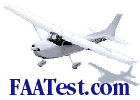Ailerons
| The ailerons control the airplane's movement about
its longitudinal axis. There are two ailerons, one at the trailing edge of
each wing, near the wingtips. They are movable surfaces hinged to the
wing's rear spar and are linked together by cables or rods so that when
one aileron is deflected down, the opposite aileron moves up (Fig. 4-2).
Contrary to popular belief, the lift on the wings is the force that
turns the airplane in flight - not the rudder. To obtain the horizontal
component of lift required to pull the airplane in the desired direction
of turn, the wings must be banked in that direction. When the pilot
applies pressure to the left on the control stick or turns the control
wheel toward the left, the right aileron surface deflects downward and the
left aileron deflects upward. |
|
 |
The force exerted by the airflow on the deflected surfaces raises the
right wing and lowers the left wing (Fig. 4-3). This happens because the
downward deflection of the right aileron changes the wing camber and
increases the angle of attack and lift on that wing. Simultaneously, the
left aileron moves upward and changes the effective camber, resulting in a
decreased angle of attack, and less lift. Thus, decreased lift on the left
wing and increased lift on the right wing causes the airplane to roll and
bank to the left.
Since the downward deflected aileron produces more lift, it also produces
more drag, while the opposite aileron has less lift and less drag. This
added drag attempts to pull or veer the airplane's nose in the direction
of the raised wing; that is, it tries to turn the airplane in the direction
opposite to that desired (Fig. 4-4). This undesired veering is referred
to as adverse yaw.
|
| To demonstrate this in flight, an attempt can be made to turn to the
right without using the rudder pedals. As right aileron pressure is
applied, the airplane rolls into a right bank and tries to turn to the
right. But the adverse yaw, or the drag on the downward deflected left
aileron, pulls the airplane's nose to the left. The airplane banks, but it
turns hesitantly and sideslips. This is undesirable and corrective action
should be taken by applying right rudder pressure.
When right rudder pressure is applied simultaneously with
right aileron pressure, it keeps the airplane from yawing opposite to the
desired direction of turn. In fact, the rudder must be used because the
ailerons were used. Therefore, neither of those controls should be used
separately when making normal turns.
To minimize this undesirable effect (adverse yaw), many airplanes are
designed with differential type ailerons or Frise type ailerons. |
|
 |
FAATest.com
- Aviation Library
Dauntless
Software hosts and maintains this library as a service to pilots
and aspiring pilots worldwide. Click
here for ways to show your appreciation for this service.
While much of this material comes from the FAA, parts of it are (c) Dauntless Software, all rights reserved. Webmasters: please
do not link directly to individual books in this library--rather,
please link to our main web page at www.dauntless-soft.com or
www.faatest.com. Thanks! |
|